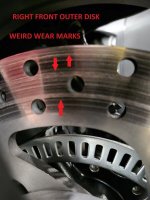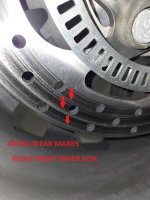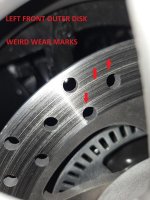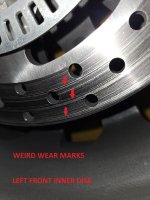GFrog
Member
Has anyone experienced this? And is this normal for these disks and pads?
With only 5000 kms (3100 miles) on my Spyder I had to replace my rotors and pads due to significant vibration and pulsing when braking. It felt like there was a warped disk somewhere on the Spyder.
I replaced them with EBC Rotors (MD853) and EBC Pads (FA630HH) for the front.
The Calipers, disks, and pad were cleaned and particle free. The hub surface was cleaned and particle free when the disk was installed.
After 350 kms (215 miles) of smooth riding with no hard or prolonged braking, the front rotors are showing the same wear pattern on the inside and outside of both rotors.
There is no brake squealing, but now I can hear the pads rubbing against the rotors when driving slowly. I assume that this must be due to the copper content of the pads causing a sort of metal-on-metal sounds at very slow speeds.
I still have some warped disk symptoms happening by not as bad as before.
I have bought the EBC Rear Rotor (MD854) and EBC Pads (FA631HH). I plan on installing those this weekend.
So is this wear pattern and sound normal?
Thanks




With only 5000 kms (3100 miles) on my Spyder I had to replace my rotors and pads due to significant vibration and pulsing when braking. It felt like there was a warped disk somewhere on the Spyder.
I replaced them with EBC Rotors (MD853) and EBC Pads (FA630HH) for the front.
The Calipers, disks, and pad were cleaned and particle free. The hub surface was cleaned and particle free when the disk was installed.
After 350 kms (215 miles) of smooth riding with no hard or prolonged braking, the front rotors are showing the same wear pattern on the inside and outside of both rotors.
There is no brake squealing, but now I can hear the pads rubbing against the rotors when driving slowly. I assume that this must be due to the copper content of the pads causing a sort of metal-on-metal sounds at very slow speeds.
I still have some warped disk symptoms happening by not as bad as before.
I have bought the EBC Rear Rotor (MD854) and EBC Pads (FA631HH). I plan on installing those this weekend.
So is this wear pattern and sound normal?
Thanks




Last edited by a moderator:

